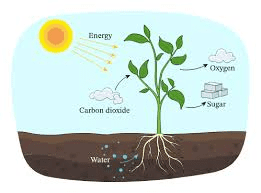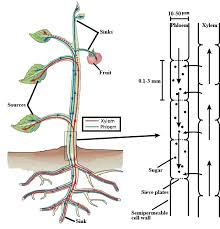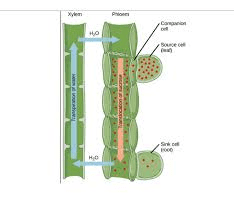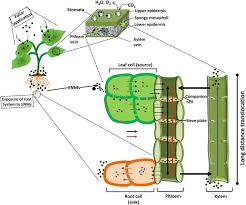When plants create nutrients in their leaves, how do materials get to the rest of the plant? When you eat, how does the food get to where it should go? Of course, plants don’t consume food the way we do.
Instead, they create food in their leaves during photosynthesis by transforming water and carbon dioxide into carbohydrates which they can use for energy.
Since photosynthesis only occurs in the leaves, that means plants have to have some way of transporting these sugars into other areas of the plant that need it, such as the stems, roots, and flowers.
This transport of materials from the leaves to other parts of the plant is known as translocation. All living organisms need energy for carrying out daily life activities, be it absorption, transport, movement, reproduction or even breathing.
Before this process of energy release takes place, two basic and fundamental reactions have to occur, photosynthesis and respiration. But in this unit we will treat translocation and respiration.
How exactly do the sugars and other materials get from the leaves into the areas where they are needed? These materials start in the leaves, which are known as sugar sources because they have an abundance of sugar following photosynthesis.
First they have to move into the phloem, and this is accomplished either of the two ways. In some plants, it is directly transported into the phloem using sugar transport proteins.
In others, it makes its way in through small openings in the phloem cell walls, and is then converted into larger forms so that it cannot move back out. With either method, the result is a buildup of sugar in the plant body system.
The phloem moves the sugars into sugar sinks, or areas where there is a lack of sugar, such as the stems and flowers.
Translocation

When photosynthesis takes place within the leaves, plants have to device ways of transporting (translocation) the manufactured complex sugars called carbohydrates to others areas of need and possible storage in the plant such as the stems, roots, and flowers.
We must remember that in green plants too, not all cells, tissues and organs photosynthesized except cells that contain chloroplasts. But all the organs, tissues and cells that are not green, need food for oxidation.
Hence, food has to be translocated to all non-green parts too. This transport of materials from the leaves to other parts of the plant is known as translocation.
The Phloem and Xylem Transport Tubes

The nutrients the plant creates can’t simply stream through the leaves to the other parts of the plant. They are moved through special tubes that run all throughout the plant, known as phloem.
These long, continuous tubes extend from the leaves into every part of the plant, and new phloem are added as the plant grows, so the flow of nutrients is never interrupted.
Phloems are not hollow, open tubes. Within the phloem are xylem, which are special types of tissue that carry water and dissolved nutrients throughout the phloem. The phloem is really a series of long, connected cells containing xylem.
The connecting walls of the phloem cells look like a sieve, allowing materials to pass through uninhibited. These materials start in the leaves, which are known as sugar sources because they have an abundance of sugar following photosynthesis.
The phloems move the sugars into sugar sinks, or areas where there is a lack of sugar, such as the stems and flowers. So how exactly do the sugars and other materials get from the leaves into the areas where they are needed?
First they have to move into the phloem, and this is accomplished in one of the two ways. In some plants, it is directly transported into the phloem using sugar transport proteins.
In others, it makes its way in through small openings in the phloem cell walls, and is then converted into larger forms so that it cannot move back out.

Respiration
Respiration takes sugar either directly from photosynthesis or from breakdown of storage compounds like starch or lipids (oils), and uses its stored chemical energy to make energy currency (ATP).
The whole process of respiration can be divided into several different steps. The first part is called glycolysis which literally means sugar splitting. This occurs in the cytoplasm of the cell and does not use oxygen and produces a small amount of ATP.
Read Also : Guide to Identify the Disease Affecting your Ruminant Animals
Glycolysis also serves as the central primary metabolic pathway on which most other secondary metabolic pathways depend.
This means that crucial plant biomolecules such as proteins, lipids, starch, cellulose, DNA, RNA, chlorophyll, other pigments, plant hormones, and many others are all intricately related with metabolic flux through glycolysis.
The other parts of respiration occur in specialized organelles called mitochondria. This is where the bulk of the ATP is released in processes requiring oxygen.
All the energy required for ‘life’ processes is obtained by oxidation of some macromolecules that we call ‘food’.
Only green plants and cyanobacteria can prepare their own food by the process of photosynthesis where they trap light energy and convert it into chemical energy that is stored in the bonds of carbohydrates like glucose, sucrose and starch.
Importance of Respiration in Plant Productivity
During seed germination, seed storage proteins, carbohydrates and lipids must all be broken down to support the germinating seedling. Aerobic respiration is a crucial part of these processes.
Timing is important before seeds are planted since temperature and moisture are essential for germination. The reason for this is that respiration increases substantially with increased temperature.
If the soil temperature is too cold, respiration will be too low to metabolize seed storage reserves, and the seed cannot germinate. The fact that respiration increases with temperature also has a profound effect on adult plant productivity.
When it is very hot, many plants grow very slowly because of reduced productivity. This usually results from lack of water to support transpiration and CO2 uptake.
As temperature and light availability increase, photosynthetic output eventually plateaus because the chloroplasts have a finite light absorption capacity.
On the other hand, the rate of respiration keeps increasing as it gets hotter, which burns more and more carbohydrate.
The more respiration increases, the less net photosynthetic product. The effect of high temperature on respiration is most severe at night when there is no photosynthesis.
If nighttime when temperatures are very high, all the carbohydrate made by the plant during the day can be used up in respiration and there may be no net growth.
Factors Influencing Respiration in Plants

At this level we will limit ourselves to identifying and discussing ten factors that influence or affect respiration in plants. They are:
| 1. | Type and age of plant tissue | |
| 2. | State of respiring protoplasm | |
| 3. | Temperature | |
| 4. | Hydration of tissues | |
| 5. | Light | |
| 6. | Oxygen | |
| 7. | Carbon dioxide | |
| 8. | Inorganic salts | |
| 9. | Mechanical stimulation | |
| 10. | Wounding as a respiration stimulator |
Type and age of plant tissue: The respiratory rate depends upon the age and the nature of the tissues, since it is concerned with energetic activities. Young tissues, like the actively growing regions of the plant, have higher respiratory rate than the old or matured tissues.
In a mature tissue there is breakdown of the integrated system of energy transfer and further increase in age is associated with an increase in senescence. During senescence, proteins breakdown thereby releasing some substrates for respiration.
This normally results in an increase in respiratory rate with more production of CO2 for a brief period. This marks the collapse of the cellular organization and cells die.
The respiratory rate also varies with the type of tissues depending mostly on their metabolic status and relative availability of non-metabolic or structural components and their accessibility to oxygen.
State of respiring protoplasm: The rate of respiration depends upon the developmental stage of protoplasm. In the actively growing regions of the plant, cells are relatively rich in protoplasm with high enzymatic activity.
As these regions grow, numerous synthetic processes are taking place which require energy and this is supplied by respiration.
Read Also : How to treat Ruminant Animal Diseases
Thus, the rate of respiration is very high in these tissues. In the mature plant organ where growth has ceased, protoplasm abounds in inert matter and metabolic processes gradually decrease. Here the rate of respiration is also low.
The inert matter also increases with the age of plant cells. Evidently the rate of respiration is connected with growth.
Temperature: Temperature significantly affects the rate of respiration as it does other enzymatic processes. Lower temperature limits of respiration of a plant that lies below 10°C which are conditioned by the freezing of the tissues.
Within certain limits, an increase in temperature increases respiratory rate rapidly. With temperatures in excess of 33°C, the process of respiration which was initially very intense, soon begins to decrease and after few hours becomes weaker than at temperatures of about 20-25°C and even lower.
Hydration of tissues: The percentage of bound water in the seeds is 16% and their rate of respiration is low. With an increase in the moisture content up to 16% the respiration also increases slightly but beyond this, rise in respiration is very rapid.
The increase in respiration due to increase in water content may either be because of water which makes the respiring cells turgid; the hydrolysis of carbohydrates to soluble sugars; accelerating the action of respiratory enzymes; acting as a medium in which oxygen diffuses into the respiring protoplasm or the water concentration of the cell membranes would reduce the permeability to oxygen and CO2, the former acting as a deficient factor and the latter as a retarding factor.
Tissues saturated with water have low rate of respiration. In the wilted leaves the rate of respiration rises because starch is converted into sugar which serves as a respiratory material.
Light: Light is not essential for respiration and indirectly affects the respiratory rate. It increases respiration by raising the temperature of the green plant and also increases the amount of photosynthetic material required for respiration.
In some green tissues, it has an inhibitory effect. Red light has a greater retarding effect than blue light. In some instances, red light may increase respiration.
Oxygen: The presence of oxygen is essential for the Krebs cycle. Oxygen is the terminal acceptor of electron in the electron transport system. In general, at low O2 concentrations both aerobic and anaerobic respirations occur in the plant.
As the oxygen concentration increases from zero, the rate of aerobic respiration increases. In most of the plants the rate falls with an increase in oxygen concentration. In germinating rice grain, the increase in the rate of aerobic respiration is linear over a range of oxygen concentration.
Carbon Dioxide: Increasing the CO2 concentration of air depresses respiration. Normally, inhibition of respiration is only there if the CO2 concentration increases too high over the normal.
The anaerobic respiration in the germinating pea seeds is inhibited by about 50% carbon dioxide in the air. This is helpful in maintaining the dormant state of the seeds.
Relative changes in the carbon dioxide concentration does affect stomatal closure and opening.
Stomata get closed under the environment with high concentrations of carbon dioxide and this may thus cause inhibition of respiration. In leaf respiration, the effect of CO2 concentration is indirect one that is through the closure of stomata which limit a gaseous exchange.
This may result in increasing the internal concentration of CO2 considerably and in this way limit respiration.
Inorganic Salts: The rate of respiration increases when a plant or a tissue is transferred from water to a salt solution. The amount by which the respiration is increased over normal has been called salt respiration.
This process has been linked with absorption of salts and ions, which have high requirement of energy supplied by respiration.
Mechanical Stimulation: Leaf respiration increases by handling, stroking or bending of leaves. Response to handling decreases if it is repeated over a period of time.
It has been observed that shearing stress, gives more of stimulation to respiration and almost very little effect by compression or tension. It has also been reported that sound waves stimulate respiration but no conclusive evidence has so far been given.
Wounding as a Respiration Stimulator: Wounding of a plant organ stimulates respiration in that organ. It initiates meristematic activity in the region of the wound resulting in the development of “wound callus”.
Perhaps the increase in respiration is due to an increased availability of respiratory substrate in wounded tissues.
Further evidences for the stimulation of respiration in response to wounding are associated with the rapid oxidation of phenolic compounds, the increase in the normal process of glycolysis and oxidative catabolism in wounded tissue and the reversion of certain cells to meristematic state, followed by callus formation to heal the wound which will have high rate of respiration to those of resting or mature tissues.
In summary, all living organisms need energy for carrying out their daily life activities, be it absorption, transport, movement, reproduction or even breathing. These series of biological activities are made possible through the release of energy which is influenced by a number of factors.
When photosynthesis takes place within the leaves, plants have to device ways of transporting (translocation) the manufactured complex sugars called carbohydrates to others areas of need and possible storage in the plant such as the stems, roots, and flowers.
The nutrients the plant creates can’t simply stream through the leaves to the other parts of the plant. They are moved through special tubes that run all throughout the plant, known as phloem.
These long, continuous tubes extend from the leaves into every part of the plant, and new phloem are added as the plant grows, so the flow of nutrients is never interrupted.
The manufacture of starch and its movement through the xylem and phloem are made possible through respiratory activities of the plant. The energy ‘box’ of the living cell is the ATP. ATP is released in processes requiring oxygen (respiration) and this is influenced by series of factors.
Read Also : Meaning and Steps Involved in Waste Recycling
